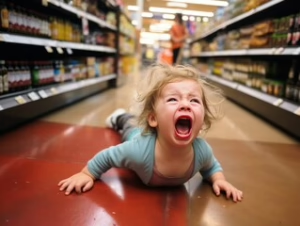 Strategies for Co-Regulating your Child’s Emotions
Strategies for Co-Regulating your Child’s Emotions
Is your toddler having a meltdown? Is your 6 year old slamming doors?
In these moments, caregivers face two difficult tasks:
- Taking a moment to keep themselves calm
- Meeting the child where they are to help them learn skills to self soothe and face future challenges
Emotions are powerful. They can prompt us to do or say things that are hurtful or regretful. As adults, we practice self-regulation all day, everyday. Instead of cutting off an inconsiderate driver and putting us both in danger, we may take a deep breath and remind ourselves we cannot control the actions of others. Yes, “take a deep breath” is an overused phrase that causes some to roll their eyes, but the most common response to panic is to hyperventilate, which is why this strategy can be helpful. There is great research to support the positive effects of deep breathing on the function of the amygdala, which is the region of the brain that controls emotion. We practice self-regulation skills to maintain healthy relationships, personal safety and that of others, and to achieve our personal and professional goals. As parents and therapists, we model these skills by taking a deep breath and saying something like, “Please clean up your Legos when you are done playing so that I don’t step on one” instead of throwing every Lego out the window. However, self-regulation is not something we are born with, it takes time to learn. Co-regulation is a great way to teach children these skills.
Explanation of Co-regulation:
Co-regulation is the process in which a caregiver or therapist helps a child manage their emotions and behaviors during inevitable challenges in life. It involves creating a safe and supportive environment through warm and responsive interactions so the individual can learn to identify and understand their feelings, and develop coping strategies.
Benefits of Co-regulation:
As children grow up, they can learn to soothe themselves and manage distressing emotions through co-regulation. This method teaches them that their emotions are a normal part of life that every person experiences, they are not alone. When their emotions are met with a non-judgmental response, they develop improved self-awareness to sort through novel and alarming experiences in the future when they do not have their co-regulation partner to assist. The co-regulation strategies transition to strong self-regulation skills used on the playground as an elementary school student and as they walk into their first job interview as a teenager or young adult. Having a strong sense of self and ability to manage emotions leads to improved social skills, sleep, attention, and reduces anxiety and stress levels.
Steps for Co-Regulation:
- Getting on their level can foster trust and connection.
- Naming their emotion validates their feelings without validating a negative behavior.
- Maintaining a calm tone and body language helps children regulate their behavior by mirroring yours.
- Giving them a hug or deep pressure squeeze can boost their oxytocin level.
- Guide them in a calming experience such as turning down the lights and noise level (or add headphones with calming music), and begin to model a deep breathing strategy.
- A Deep Breathing Example: Butterfly breathing (raise arms up as you inhale, bring them down as you exhale like you’re flying). Adding a physical component assists with body awareness and regulation. You can change the name to something that peaks their interest, i.e. bird, pterodactyl breathing, or anything else with wings. Whether they join you or not, they are learning from you.
How Pediatric Occupational Therapists Use Co-regulation:
- Sensory strategies: Using calming sensory input like deep pressure, gentle rocking, listening to calming sounds, and deep breathing techniques (further explained in the steps below).
- Social-emotional learning: Teaching emotional awareness, empathy, and problem-solving skills.
- Play therapy: Using play as a medium for children to express their emotions and practice coping strategies.
- Sensory diets: Creating personalized sensory routines to help regulate arousal levels.
- Family involvement: Guiding parents and caregivers on how to support co-regulation at home.
Difficulties of co-regulation:
Co-regulation requires patience and practice, so don’t be too hard on yourself. When you don’t respond to a child using self-regulation, this is a great opportunity to model apologizing and remind your child that adults have big emotions too, which can help them feel understood. Before a parent or trusted adult can help a child, they first need to understand and possibly expand upon their own emotional coping skills and limitations.
If you have any questions or concerns about your child’s development, Kids Place Pediatric Therapy in Arizona is here to help.
To learn more, check out the following:
- The Benefits of Deep Breathing
- The Administration for Children and Families offers a free Co-Regulation in Action video series







